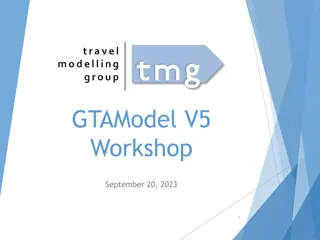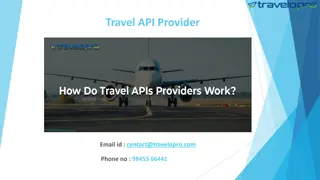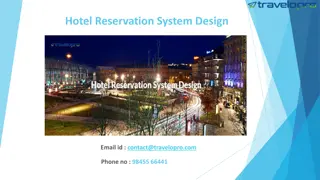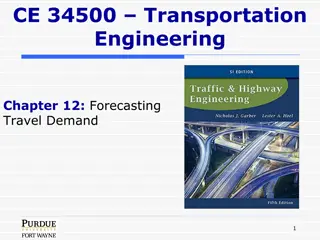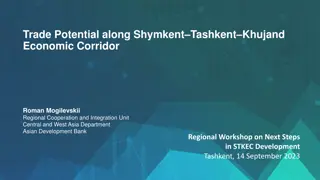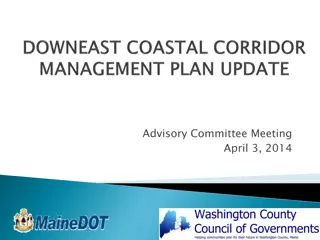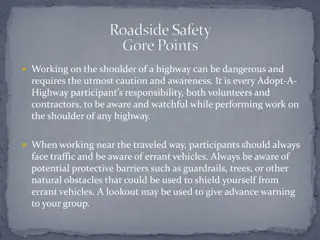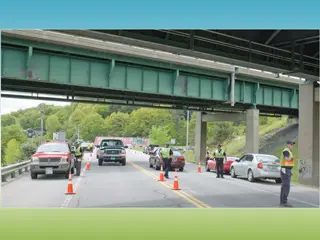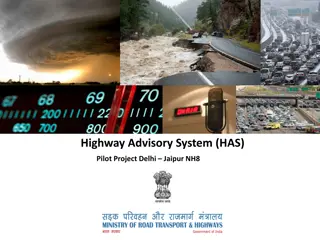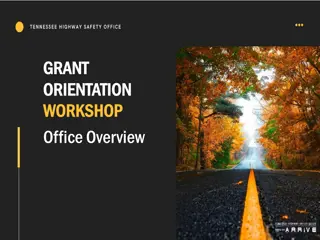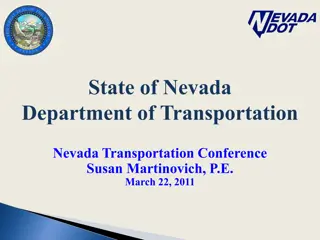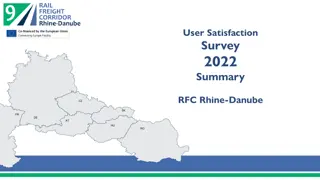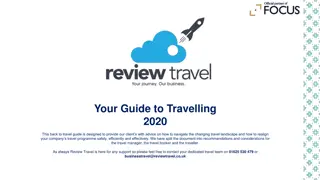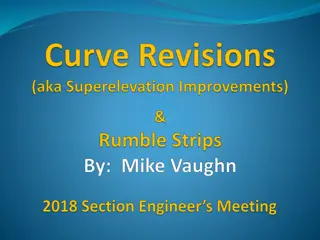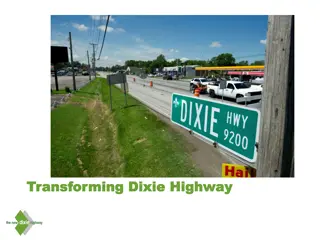Subarea and Highway Corridor Studies: Travel Demand Modeling and Refinements
In this lesson, we delve into subarea and corridor studies focusing on travel demand model refinements, highway network coding, corridor congestion relief, and trip assignment theory. Subarea modeling plays a crucial role in forecasting travel within smaller regions with detailed traffic patterns, turning movements, and accurate highway network data required. The types of subarea modeling include stand-alone and refined regional models. Techniques such as splitting large regional TAZs, disaggregating socioeconomic data, refining highway networks, and revalidating models with added details are essential for effective subarea modeling.
Download Presentation

Please find below an Image/Link to download the presentation.
The content on the website is provided AS IS for your information and personal use only. It may not be sold, licensed, or shared on other websites without obtaining consent from the author. Download presentation by click this link. If you encounter any issues during the download, it is possible that the publisher has removed the file from their server.
E N D
Presentation Transcript
LESSON 8 SUBAREA AND HIGHWAY CORRIDOR STUDIES 1
PART A REFINE MODEL WITHIN CORRIDOR FSUTMS COMPREHENSIVE MODELING WORKSHOP 2
LESSON GOALS In this lesson we will discuss: Travel demand model refinements for subarea and corridor studies Highway network coding for complex roadway types Corridor congestion relief and trip assignment theory FSUTMS COMPREHENSIVE MODELING WORKSHOP 3
TRAVEL DEMAND MODELING FOR SUBAREA Overview: Subarea modeling is used to forecast travel in a smaller region such as corridors and central business districts at a much finer detail Subarea models are developed to capture traffic patterns and turning movements with better accuracy over a small area Subarea models require detailed highway network data FSUTMS COMPREHENSIVE MODELING WORKSHOP 4
TYPES OF SUBAREA MODELING Stand-alone sub area model This method involves extracting trip tables and networks for the sub area from the regional model. This model uses external stations to exchange trips with the rest of the regional model Refine regional model This method involves disaggregating zones and/or adding additional network details at the sub area level within the regional model FSUTMS COMPREHENSIVE MODELING WORKSHOP 5
OUTLINE Travel Demand Modeling for Subarea: Split large regional TAZs into smaller TAZs Disaggregate socioeconomic data for subarea TAZs Refine highway network in subarea Revalidate the model with added detail FSUTMS COMPREHENSIVE MODELING WORKSHOP 6
SPLIT TAZS Split TAZs inside subarea to better represent land use patterns and trip origin/destination locations TAZ 1 TAZ 1 TAZ 2 FSUTMS COMPREHENSIVE MODELING WORKSHOP 7
DISAGGREGATE SOCIOECONOMIC DATA Disaggregate socioeconomic data from regional TAZs to split TAZs in the subarea based on the land use patterns and trip origin/destination locations TAZ 1 (Pop: 0, Emp: 300) TAZ 1 (Pop: 500, Emp:300) TAZ 2 (Pop: 500, Emp: 0) FSUTMS COMPREHENSIVE MODELING WORKSHOP 8
DETAIL HIGHWAY NETWORK Add links, nodes, and centroid connectors to the highway network inside the subarea to better represent local circulators and access points in the transportation network TAZ 1 TAZ 1 Network Link Centroid Connector Local Circulator Centroid Nodes TAZ 2 FSUTMS COMPREHENSIVE MODELING WORKSHOP 9
REVALIDATE MODEL Map volume-over-count ratios for the refined subarea model and compare with unrefined regional model Summarize model statistics (RMSE, VMT, etc.) for refined subarea model and compare against original regional model If possible, summarize statistics at both the regional and subarea geographies Traffic Assignment Summary (Comparison at Original & New Count Locations) Volume-to-Count Ratio by Facility Type Rockdale County Regionwide Facility Type * Original ARC 2005 Model (Original Counts) 1.05 n/a n/a 1.14 1.54 0.69 1.12 Refined 2005 Model (Original Counts) 1.04 n/a n/a 1.05 1.48 0.82 1.10 Refined 2005 Model * Original ARC 2005 Model (Original Counts) 1.01 0.94 n/a 1.12 1.08 0.87 1.04 Refined 2005 Model (Original Counts) 0.98 0.92 n/a 1.09 1.06 0.85 1.02 Refined 2005 Model (All Counts including Ramps) 1.04 n/a 0.94 ** 1.10 1.27 0.79 1.09 (All Counts including Ramps) 0.98 0.92 0.94 ** 1.09 1.06 0.85 1.02 Freeway/Expressway HOV Ramps FSUTMS COMPREHENSIVE MODELING WORKSHOP Principal Arterial Minor Arterial Collector Total 10
END OF LESSON 8, PART A INDEPENDENT EXERCISE 34: SPLIT ZONES FSUTMS COMPREHENSIVE MODELING WORKSHOP 11
PART B HIGHWAY NETWORK CODING FOR COMPLEX ROADWAY TYPES FSUTMS COMPREHENSIVE MODELING WORKSHOP 12
OUTLINE Highway network coding for complex roadway types: Limited access highways and interchanges Modeling managed lanes Coding toll highways FSUTMS COMPREHENSIVE MODELING WORKSHOP 13
LIMITED ACCESS HIGHWAYS AND INTERCHANGES Interchange facility types Access through ramps only Freeway-arterial interchange Freeway-freeway interchange FSUTMS COMPREHENSIVE MODELING WORKSHOP 14
FSUTMS FACILITY TYPES FOR INTERCHANGES FSUTMS Facility Types: 71 - Freeway On-Ramp 72 Freeway Loop On-Ramp 73 Other On-Ramp 74 Other Loop On-Ramp 75 Freeway Off-Ramp 76 Freeway Loop Off-Ramp 77 Other Off-Ramp 78 Other Loop Off-Ramp 79 Freeway-Freeway High-Speed Ramp FSUTMS COMPREHENSIVE MODELING WORKSHOP 15
FREEWAY-ARTERIAL INTERCHANGE Unidirectional links for limited access highways and interchanges No centroid connectors on limited access highways Access through ramps Ramps are coded in multiple links to follow the curvature of the roadway Arterial Loop Off-Ramp On-Ramp Limited Access Highway WB Direction Limited Access Highway EB Direction Loop On-Ramp Off-Ramp Node FSUTMS COMPREHENSIVE MODELING WORKSHOP 16
FREEWAY-ARTERIAL INTERCHANGE (CONTD) FSUTMS COMPREHENSIVE MODELING WORKSHOP 17
FREEWAY-ARTERIAL INTERCHANGE (CONTD) Example of coding prohibitors for proper access Would not cross traffic to take loop ramp FSUTMS COMPREHENSIVE MODELING WORKSHOP 18
FREEWAY-FREEWAY INTERCHANGE Node Freeway-Freeway High-Speed Ramp Limited Access Highway WB Direction Limited Access Highway EB Direction Loop Ramp Limited Access Highway NB Direction Limited Access Highway SB Direction FSUTMS COMPREHENSIVE MODELING WORKSHOP 19
FREEWAY-FREEWAY INTERCHANGE FSUTMS COMPREHENSIVE MODELING WORKSHOP 20
MANAGED LANES Managed lanes represent a portion of a highway facility that is restricted to a select class of occupant or vehicle Managed lanes are coded as separate parallel links from mainline links with unique facility types During trip assignment, rules are established to route trips on managed links based on conditions such as vehicle occupancy, time of day, toll rates, etc. Connecting links from general purpose lanes to managed lanes often have restrictions placed on them, including the use of time penalties FSUTMS COMPREHENSIVE MODELING WORKSHOP 21
MANAGED LANES EXAMPLES High Occupancy Vehicles (HOV) Lanes restricted to 2 or 3+ occupant vehicles High Occupancy Toll Lanes typically, HOVs travel for free while others pay a variable toll for using these lanes Truck Only Lanes restricted to commercial vehicles Express Lanes restricted access and egress to only select interchanges FSUTMS COMPREHENSIVE MODELING WORKSHOP 22
FSUTMS FACILITY TYPES FOR MANAGED LANES 81 Freeway Group 1 HOV Lane (Barrier-Separated) 82 Other Freeway HOV Lane (Barrier-Separated) 83 Freeway Group 1 HOV Lane (Non-Separated) 84 Other Freeway HOV Lane (Non-Separated) 85 Non-Freeway HOV Lane 86 AM & PM Peak HOV Ramp 87 AM Peak Only HOV Ramp 88 PM Peak Only HOV Ramp 89 All Day HOV Ramp FSUTMS COMPREHENSIVE MODELING WORKSHOP 23
CODING OF MANAGED LANES WITH PENALTIES General Purpose Lanes (FT 1x) HOV Lanes (FT 8x) General Purpose Lanes (FT 1x) FSUTMS COMPREHENSIVE MODELING WORKSHOP 24
IMPLEMENTATION OF TOLL PROCEDURE FSUTMS/Voyager models with toll modeling capabilities read the TOLLLINK file Cost and service time attributes are appended to the highway network as link attributes, except for open road tolling situations Toll impacts to highway skims are calculated from link attributes during highway network phase Typically, there are no specific adjustments needed to activate toll modeling FSUTMS COMPREHENSIVE MODELING WORKSHOP 25
FSUTMS FACILITY TYPES FOR TOLL LINKS 91 Freeway Group 1 Toll Facility 92 Other Freeway Toll Facility 93 Expressway/Parkway Toll Facility 94 Divided Arterial Toll Facility 95 Undivided Arterial Toll Facility 97 Toll On-Ramp 98 Toll Off-Ramp 99 Toll Plaza FSUTMS COMPREHENSIVE MODELING WORKSHOP 26
TOLL LINKS ON NETWORK FT99 0.2 0.2 0.1 LEGEND Acceleration Link Deceleration Link Toll Plaza Link 0.2 FT99 Node Recommended Link Distance 0.1 Direction of Flow 0.2 0.2 Facility Type 99 = Toll Plaza Links FT99 0.2 0.2 0.1 FSUTMS COMPREHENSIVE MODELING WORKSHOP 27
DELAY CALCULATIONS IN TOLL MODEL Deceleration Acceleration Plaza queuing delay Open road tolling (no queuing delay) Impedance due to value of toll Iterative adjustment of congested times FSUTMS COMPREHENSIVE MODELING WORKSHOP 28
END OF LESSON 8, PART B PLEASE PROCEED TO GUIDED EXERCISES 35, 36, 37, AND 38 FSUTMS COMPREHENSIVE MODELING WORKSHOP 29
PART C TEST ALTERNATIVE TO RELIEVE CONGESTION ALONG CORRIDOR FSUTMS COMPREHENSIVE MODELING WORKSHOP 30
START OUTLINE Generation Test Alternative to Relieve Congestion: Trip assignment theory: Equilibrium Assignment Process Testing of corridor alternatives: Types of Alternatives Evaluating Alternatives Network Distribution Transit Mode Split Assignment Reporting END FSUTMS COMPREHENSIVE MODELING WORKSHOP 31
TRIP ASSIGNMENT Trip assignment is the process whereby trips are assigned to various available paths or routes in a network according to an assignment model Trips are sometimes loaded separately by auto occupancy and vehicle class to allow for testing of managed lanes FSUTMS uses the Equilibrium Highway Assignment Process FSUTMS COMPREHENSIVE MODELING WORKSHOP 32
TRIP ASSIGNMENT (CONTD) What are the results of trip assignment? Number of daily (24-hour) trips on each link in the network Number of trips per period on each link in the network for a Time-of-Day (TOD) assignment Assignments are used for: Network validation Development and testing of transportation system alternatives Analysis of traffic impacts Estimation of traffic forecasts for roadway design Generating volumes for use in traffic simulations FSUTMS COMPREHENSIVE MODELING WORKSHOP 33
EQUILIBRIUM HIGHWAY ASSIGNMENT Assignment equilibrium occurs when no trip can be made by alternate paths without increasing the total travel time of all trips in a network Equilibrium assignments are considered multipath because the final loads are a linear combination of the all-or-nothing loads of each iteration Each load may be assigned to a different path due to the adjustment of speeds after each iteration FSUTMS COMPREHENSIVE MODELING WORKSHOP 34
EQUILIBRIUM HIGHWAY ASSIGNMENT (CONTD) A series of iterative all-or-nothing assignments Adjustment of travel times reflecting delays encountered in the associated iteration Combining loads with previous loads to minimize the impedance of each trip Pre-loading is used for trip types that are considered not sensitive to congestion (such as truck trips and external-external trips using BPR formula) FSUTMS COMPREHENSIVE MODELING WORKSHOP 35
EQUILIBRIUM HIGHWAY ASSIGNMENT (CONTD) Beta Default BPR Speed-Volume Curve (Exponent) 4 ???????? ?????? ????????? ???????? ??= ?? 1 (1.0 + 0.15 Alpha (Constant to adjust for LOS) Where: Tn = Adjusted time for iteration n Tn-1 = Time from previous iteration Assigned Volume = Assigned 24 hour daily volume Practical Capacity = Capacity (Factored using CONFAC) at specific level of service based on application of UROAD factors. FSUTMS COMPREHENSIVE MODELING WORKSHOP 36
EQUILIBRIUM HIGHWAY ASSIGNMENT (CONTD) Equilibrium Sample 3 paths between zones A and B 100 0 0 First all-or-nothing assignment, all 100 trips from A to B are assigned to the top path The first iteration of capacity restraint adjusts the link time on that path based upon the BPR curve and reloads the network, again using an all-or-nothing assignment, which results in 100 trips on the center path that is now the minimum path Program computes a combining factor using a non-linear algorithm In this example the factor is 0.75, or .75 x 100 to center path and .25 x 100 to top path A Iteration 0 0 100 0 A B 25 75 0 A Iteration 1 FSUTMS COMPREHENSIVE MODELING WORKSHOP 37
EQUILIBRIUM HIGHWAY ASSIGNMENT (CONTD) Equilibrium Sample (Cont d) Second iteration, again using an all-or-nothing assignment, results in 100 trips on the bottom path which is now the minimum path Program then computes a combining factor using a non- linear algorithm In this example the factor is 0.23, or 0.23 x 100 to bottom path, this leaves 0.77 for the other paths - 0.77 x 25 to the top path and 0.77 x 75 to the bottom path Note that 19 + 58 + 23 = 100 trips 0 0 A B 100 19 58 23 B A Iteration 2 FSUTMS COMPREHENSIVE MODELING WORKSHOP 38
EQUILIBRIUM HIGHWAY ASSIGNMENT (CONTD) Equilibrium Sample (Cont d) Third iteration puts all 100 trips on the links to the top path again, calculates a new factor of 0.05, assigns an additional four trips to the links of the top path and reapportions the remainder based on the results of the previous iterations. The process stops when the factor gets close enough to zero, or the user-specified number of iterations is completed 100 0 0 A B 23 55 22 B A Iteration 3 FSUTMS COMPREHENSIVE MODELING WORKSHOP 39
OLYMPUS TRIP ASSIGNMENT MODEL FSUTMS COMPREHENSIVE MODELING WORKSHOP 40
OLYMPUS TRIP ASSIGNMENT MODEL (CONTD) Assignment detailed flow chart includes highway and transit. FSUTMS COMPREHENSIVE MODELING WORKSHOP 41
TESTING OF CORRIDOR ALTERNATIVES Types of Alternatives: Additional lanes (or lane reductions) New roadway segments Turn prohibitions/access management Directional flow (one-way to two-way or vice versa) Grade Separations: Managed lanes Fixed guideway or mixed flow transit FSUTMS COMPREHENSIVE MODELING WORKSHOP 42
TESTING OF CORRIDOR ALTERNATIVES (CONTD) Statistics for evaluation corridor alternatives: Volume-over-capacity Traffic volumes Lane-miles of congestion Congested speeds Person throughput Transit ridership for transit alternatives FSUTMS COMPREHENSIVE MODELING WORKSHOP 43
TESTING OF CORRIDOR ALTERNATIVES (CONTD) Post processing tools for evaluating corridor alternatives: Traffic flow bandwidth maps View turn volumes LOS Manager/GIS-TM Your own ideas FSUTMS COMPREHENSIVE MODELING WORKSHOP 44
END OF LESSON 8, PART C PLEASE PROCEED TO GUIDED EXERCISES 39 AND 40 INDEPENDENT EXERCISE 41: WAYS TO RELIEVE CONGESTION FSUTMS COMPREHENSIVE MODELING WORKSHOP 45



